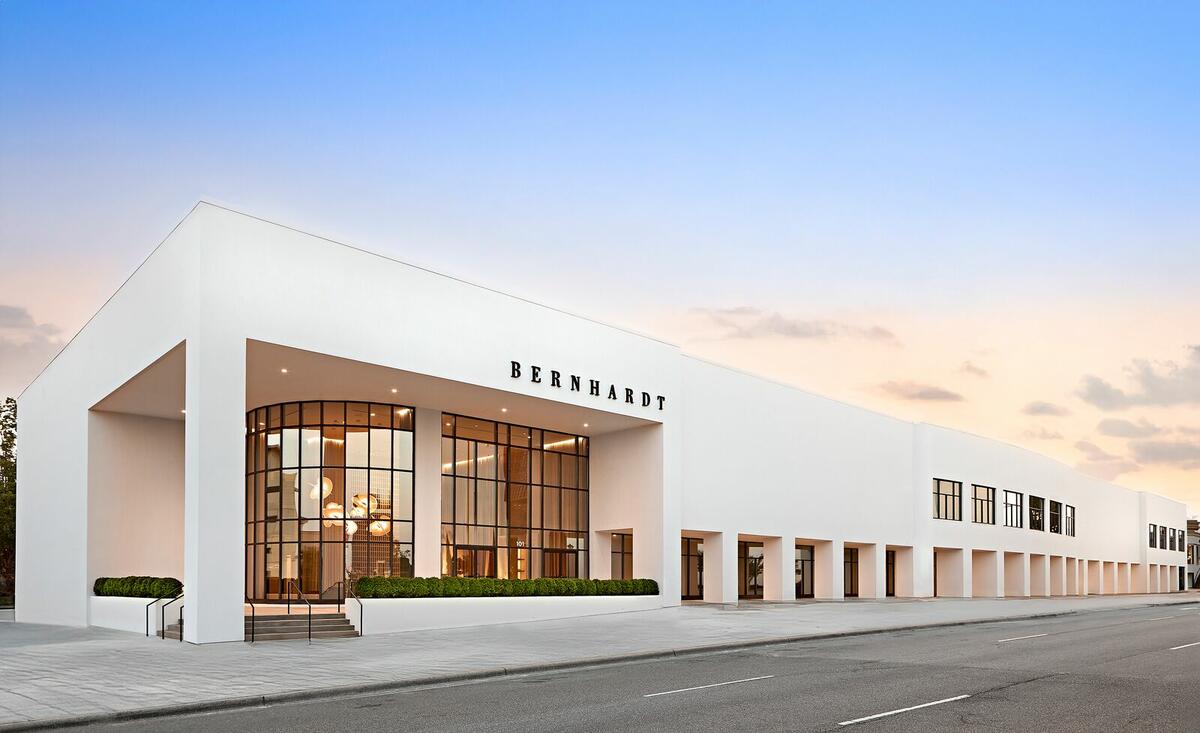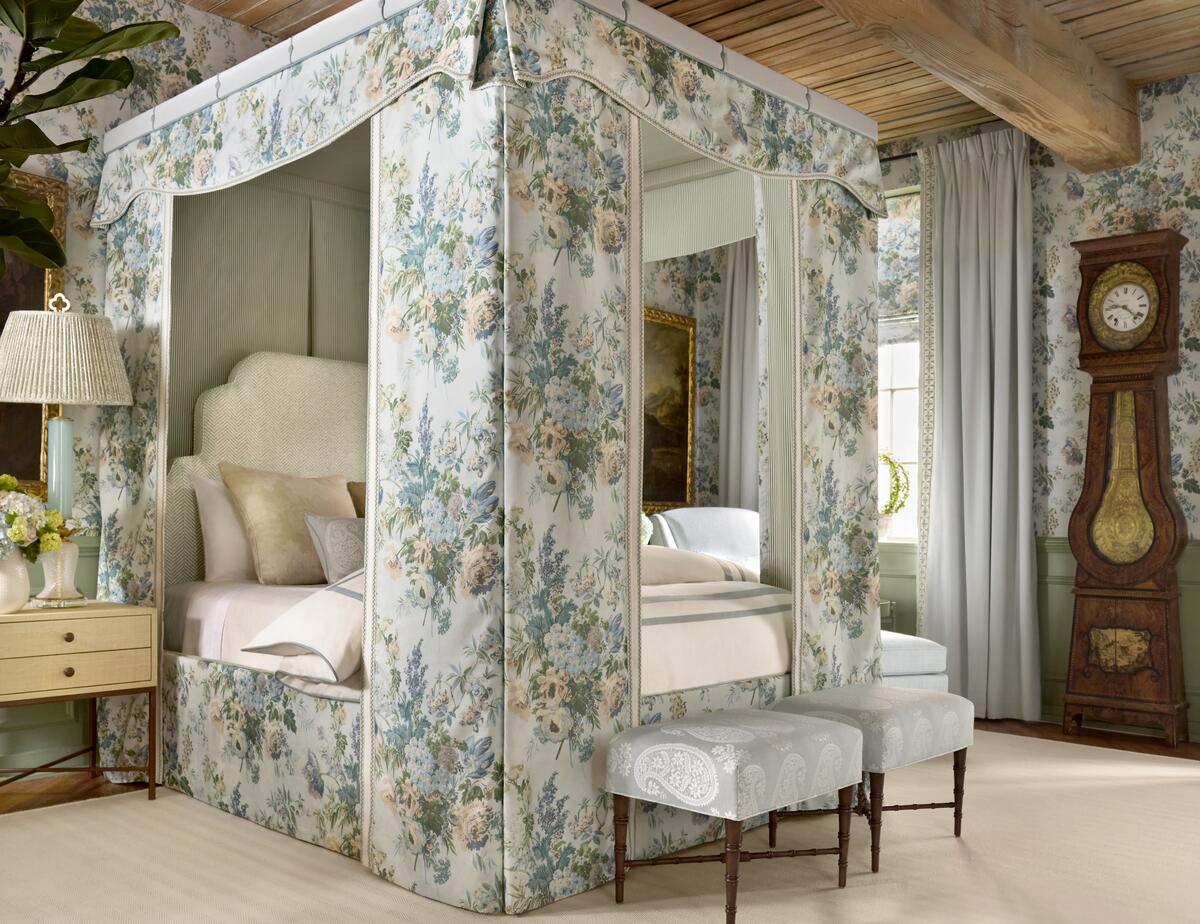As the trees came into bloom this weekend, the design industry descended upon High Point, North Carolina. A mix of panic and steely resolve hung over the entire Market: Both the immediate turmoil wrought by tariffs and the existential dread of a potential impending recession were clearly top of mind for exhibitors large and small. Still, there was shopping to be done and connections to be made. Business of Home’s editorial team was on the ground to take it all in—read on to find out what mattered most at High Point Market this season.
TRAFFIC PATTERNS
Given widespread economic uncertainty, perhaps it’s no surprise that many buyers decided to stay home this spring. According to badge-scan data from High Point Market Authority, designer attendance was down nearly 7 percent from the Fall Market numbers; there was also a notable (and understandable) 14 percent dip in international buyers. That thinning of the crowds was palpable on the street and in the hallways of some of the larger buildings. It was also the talk of most showrooms: “It’s a little slow, don’t you think?”
There were some exceptions. Several brands reported surges in attendance—outperforming not only their last year’s numbers, but High Point Market’s at large. Notably, all of them had invested in marketing their story; they saw designers reward those efforts by showing up in droves to see the latest. It was a good reminder that while the event’s attendance goes up and down, each building and brand still has the opportunity to shape its own fate.
Registration data on the retail side showed buyers out in force: While there were 3.9 percent fewer companies represented than at last fall’s event, individual contacts were only down 0.2 percent, signaling that the brands that did make the trip brought enough extra team members to bridge the gap. Anecdotally, those buyers explored Market more adventurously than usual, looking for new manufacturing partners with less exposure to tariffs (more on that later).
A sense that the sidewalks felt wider this spring may also speak to the ever-expanding duration of Market. The show officially opens on Saturday, but designers and boutique retailers shopping for one-of-a-kinds or looking to get dibs on floor models arrived as early as Wednesday—and some of the biggest retailers touched down on Tuesday and were long gone by the weekend, leaving the rest of us to worry about the lack of crowds.
TARIFF TALK
There’s no getting around it: Tariffs were the defining characteristic of this Market. Responses to the supply chain upheaval, though, were decidedly mixed. Where some manufacturers showed signs of strain (“We’re freaking out,” said one), others had a more measured reaction.
Price increases were common, though they took different forms. Some brands raised prices by a moderate percentage across the board (typically in the range of 2 to 7 percent) in an attempt to cover tariff-related costs—the type of increase that will likely be lasting. Others got specific and calculated the exact increase per piece that has resulted from tariffs, then tacked that amount onto their invoice as a separate, taxable line item that can be adjusted as the rates shift. (Though tariffs themselves are a form of tax, the rising costs of a finished good are still subject to sales tax—a fact that manufacturers said came as a surprise to many Marketgoers.) Communicating this add-on charge can take on a political dimension: In two back-to-back appointments with brands taking this approach, the first told me that the line item would simply be called “surcharge”; the second, which is going with “tariff surcharge,” voiced a strong preference for making it clear that the new costs are tied to the Trump administration—a microcosm of a debate that’s playing out among American retailers across the board.
Others relied on messaging to convey the unknowns. The most compelling example could be found at Rowe, which has traditionally offered more than a thousand fabrics—many of which come from China. Rather than restrict its offering or issue across-the-board increases, the company chose to create a volatility scale, sorting its program into low (domestic fabrics), moderate (fabrics imported from Europe, Turkey, Vietnam, India and South Korea), or high (those imported from China). In my conversation with the company’s CEO, Bobby Robinson, he stressed that his goal was to give buyers the clarity to make educated sourcing decisions.
For domestic manufacturers—some of which may only need to regrade a few imported fabrics to reflect a shift in pricing—opportunities seemed abundant. One told me that the company had been inundated with retailers looking for new partners—people who came in sheepishly saying, “I’m so sorry I’ve never returned your emails, but I’d love to do business now.” (While domestic manufacturers seemed to relish a flood of new faces, most were approaching the influx with caution. The recent pandemic boom-and-bust is close enough in the rearview window that none were in the mood to rapidly expand, and most were only looking to take on new partners that would foster modest, incremental growth for their businesses.)

New and Refreshed Showrooms
There were plenty of pleasant surprises to lift the spirits—notably, the new and revamped spaces of several major exhibitors. Bernhardt made the biggest splash with its striking, stark-white overhaul of the former Klaussner building on North Hamilton Street, where it threw a rager on Saturday evening that featured live music and bustling crowds (and rumored sightings of an attendee’s pet Bengal cat).
Meanwhile, just down the block, Hamilton Place got a few fresh faces with the opening of new showrooms by Adriana Hoyos and Burton James. Across the street, Universal debuted a revamped Designer’s Lounge inspired by The Ludlow Hotel’s moody, studious lobby bar; and in IHFC, Currey & Company unveiled a thoughtful overhaul of its ground-floor showroom to improve traffic flow and product discovery.
Hot Spots
In its second Market, the new 313 Space complex continued to be the talk of the town. Brimming with a mix of established brands and boutique makers, the artisan-driven building—anchored by the ground-floor Schwung showroom—was the can’t-miss destination of the season. New and returning exhibitors alike gushed about the high-end design firms passing through, and seemed to be in high spirits amid a relatively somber Market.
Elsewhere, the Markor brands looked especially vibrant. Caracole put a spotlight on the sleek, sculptural pieces that debuted at the company’s first showing in Milan earlier this month, while sister brand A.R.T. Furniture looked better than ever under the leadership of president Roger Turnbow. A hint that similar transformations are afoot was also spotted at Norwalk, where president and CEO Tim Newlin unveiled new frames and fabrics—as well as a new merchandising approach that feels especially promising—working hand in hand with Los Angeles designer Kim Salmela. And across my several visits, the Four Hands showroom was continuously bustling with designers raving about the brand’s new collaboration with Crypton Fabric; an of-the-moment mixed-materials story with pops of merlot-hued accent pieces; and an inspired art collection featuring both reproductions and original works.

Design Trends
One unmistakable trend throughout town was a shift toward sweetness. Often, that took the form of traditional details—billowing skirts on seating of all sizes, as well as elegant box pleats, flowing fringe or delicate contrast piping. At Thibaut, the latest introductions from Anna French were showcased in a setting featuring window treatments with dainty beaded trims and a dreamy canopy bed that paired large-scale florals with ticking stripes. Those motifs were also in full force at Coley Home, Highland House and Cisco Home, where we swooned over a trio of voluminously skirted sofas and chairs in rich butter yellow linen. Scalloped details also entered the chat, from a playful end-of-bed bench at Made Goods (trimmed in fringe, no less) to a confection-like table in duck egg blue at A.R.T. and the squiggled backs of the dining chairs from new-to-Market brand Co.House Designs, which was showing its wares in InterHall.
Rich, vibrant colors were also a mainstay this spring—luscious berry hues, fiery persimmon shades, yellows of all types, and bright, springy greens seemed to be everywhere we looked. Verellen, which notably embraced color in its assortment for the first time last fall, went all in on deep aubergine; at Chaddock, the standout Americana-inflected introductions from designer Mark D. Sikes were decked out in a pitch-perfect jade green.
Finally, savvy brands have started turning their attention to kitchen and bath. Cambria presented a line of freestanding cabinet furniture by Stoffer Home, including a kitchen island, while Currey & Company and Made Goods continued to spotlight their vanities. That push was also front and center at Barrett Bergmann Home, a new brand from designers Kyle Barrett and Dwayne Bergmann that used its plum spot at the entrance of InterHall to showcase a customizable vanity line featuring a wide array of options and competitive designer pricing.




























